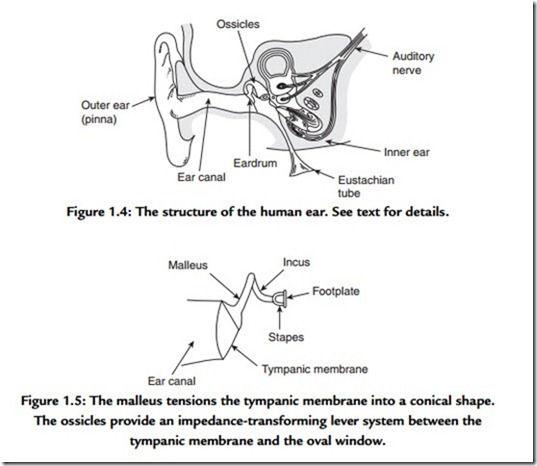Sound and the Ear
Experiments can tell us that the ear only responds to a certain range of frequencies within a certain range of levels. If sound is defined to fall within those ranges, then its reproduction is easier because it is only necessary to reproduce those levels and frequencies that the ear can detect.
Psychoacoustics can describe how our hearing has finite resolution in both time and frequency domains such that what we perceive is an inexact impression. Some aspects
of the original disturbance are inaudible to us and are said to be masked. If our goal is the highest quality, we can design our imperfect equipment so that the shortcomings are masked. Conversely, if our goal is economy we can use compression and hope that masking will disguise the inaccuracies it causes.
A study of the finite resolution of the ear shows how some combinations of tones sound pleasurable whereas others are irritating. Music has evolved empirically to emphasize primarily the former. Nevertheless, we are still struggling to explain why we enjoy music and why certain sounds can make us happy whereas others can reduce us to tears. These characteristics must still be present in digitally reproduced sound.
The frequency range of human hearing is extremely wide, covering some 10 octaves (an octave is a doubling of pitch or frequency) without interruption.
By definition, the sound quality of an audio system can only be assessed by human hearing. Many items of audio equipment can only be designed well with a good knowledge of the human hearing mechanism. The acuity of the human ear is finite but astonishing. It can detect tiny amounts of distortion and will accept an enormous dynamic range over a wide number of octaves. If the ear detects a different degree of impairment between two audio systems in properly conducted tests, we can say that one of them is superior.
However, any characteristic of a signal that can be heard can, in principle, also be measured by a suitable instrument, although in general the availability of such
instruments lags the requirement. The subjective tests will tell us how sensitive the instrument should be. Then the objective readings from the instrument give an indication of how acceptable a signal is in respect of that characteristic.
The sense we call hearing results from acoustic, mechanical, hydraulic, nervous, and mental processes in the ear/brain combination, leading to the term psychoacoustics. It is only possible to briefly introduce the subject here. The interested reader is referred to Moore1 for an excellent treatment.
Figure 1.4 shows that the structure of the ear is divided into outer, middle, and inner ears. The outer ear works at low impedance, the inner ear works at high impedance, and the middle ear is an impedance matching device. The visible part of the outer ear is called the pinna, which plays a subtle role in determining the direction of arrival of sound at high frequencies. It is too small to have any effect at low frequencies. Incident sound enters the auditory canal or meatus. The pipe-like meatus causes a small resonance at around
4 kHz. Sound vibrates the eardrum or tympanic membrane, which seals the outer ear from the middle ear. The inner ear or cochlea works by sound traveling though a fluid. Sound enters the cochlea via a membrane called the oval window.
If airborne sound were to be incident on the oval window directly, the serious impedance mismatch would cause most of the sound to be reflected. The middle ear remedies that mismatch by providing a mechanical advantage. The tympanic membrane is linked to the oval window by three bones known as ossicles, which act as a lever system such that a large displacement of the tympanic membrane results in a smaller displacement of the oval window but with greater force. Figure 1.5 shows that the malleus applies a tension to the tympanic membrane, rendering it conical in shape. The malleus and the incus are firmly joined together to form a lever. The incus acts on the stapes through a spherical joint. As the area of the tympanic membrane is greater than that of the oval window, there is further multiplication of the available force. Consequently, small pressures over the large area of the tympanic membrane are converted to high pressures over the small area of the oval window.
The middle ear is normally sealed, but ambient pressure changes will cause static pressure on the tympanic membrane, which is painful. The pressure is relieved by the Eustachian tube, which opens involuntarily while swallowing. The Eustachian tubes open into the cavities of the head and must normally be closed to avoid one’s own speech appearing deafeningly loud.
The ossicles are located by minute muscles, which are normally relaxed. However, the middle ear reflex is an involuntary tightening of the tensor tympani and stapedius muscles, which heavily damp the ability of the tympanic membrane and the stapes to transmit sound by about 12 dB at frequencies below 1 kHz. The main function of this reflex is to reduce the audibility of one’s own speech. However, loud sounds will also trigger this reflex, which takes some 60 to 120 ms to occur, too late to protect against transients such as gunfire.
